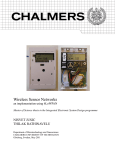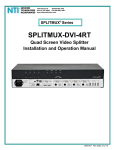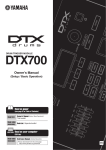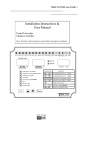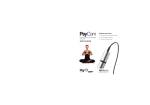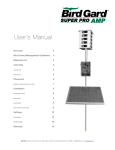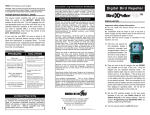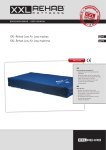Download User Manual - Scarecrow Bio
Transcript
USERS INSTRUCTION MANUAL SCARECROW B.I.R.D. SYSTEM™ CONTENTS Page 1-2 - Items Supplied and Available Accessories Pages 2-4 - Practical Setup Tips Page 5 - Assembly / Fixing Pages 6-7 - Power Supply and Connections Page 8-9 - System Design Page 10 - Keypad Guide and Default Settings Page 11 - Turning the Unit On/Off Pages 12- - Programming Instructions Page 15 - Other Features Page 16 - Pin Control / Use Page 17 - Re-Set Default Factory Settings and Technical Support ITEMS SUPPLIED SCARECROW B.I.R.D. SYSTEM™ A fully automatic and random play bird dispersal system, incorporating: • • • • • • • • Random play bird dispersal processor 10 standard distress calls Integrated Long Line Transformer Built in keypad for setting controls Built in light sensor Capable of hosting up to 30 loudspeakers (SEE BELOW). Power Supply; 15V dc regulated switch mode; choice of EU/UK plug top 4 x 1215/L Loudspeakers - IP65 rated 20 watt re-entrant horn loudspeaker, fitted with fully adjustable mounting bracket. Standard calls: Herring Gull, Black Headed Gull, Starling, Rook, Crow, Pigeon, Jackdaw, Canada Goose 1, Canada Goose 2 and Birds of Prey ADDITIONAL LOUDSPEAKERS: OPTIONS • 1212/L LOUDSPEAKER; IP65 rated 10 watt re-entrant horn loudspeaker fitted with fully adjustable mounting bracket. Used where a more specific “directional” broadcast is required. • 1215/L LOUDSPEAKER; IP65 rated 20 watt re-entrant horn loudspeaker, fitted with fully adjustable mounting bracket. Page 1 Note: The 1220/L LOUDSPEAKER Class 1 ‘EexmN’ is for use in hazardous atmospheres, and more detail is provided in the appropriate manual. If the Scarecrow B.I.R.D. System™ processor unit can be situated in a safe environment, but the 1220/L speakers are required in view of the site environment, then the 4 x 1212L/1215L speakers provided as standard with the normal Scarecrow B.I.R.D. System™ price will be upgraded to 1220L speakers, subject to the appropriate additional payment. ACCESORY ITEMS AVAILABLE Solar Power Option; suitable for B.I.R.D. System™, Scarecrow 180™ and Scarecrow 360™ System. System comprises: • Solar Panel – Pole mount only • Battery & regulator pack - Option for wall or pole mounting Ambient Light Sensor; to facilitate Dawn / Dusk function only when main Scarecrow B.I.R.D. System™ processor (with built in light sensor) has to be located indoors. Should the above accessories be required please contact your supplier, or Scarecrow direct, on [email protected] PRACTICAL TIPS Point of Broadcast • Ideally, the point of broadcast should be from a high point – too low to the ground will only limit the area covered, and therefore the success obtained. Volume Levels • The volume of broadcast has to be at a natural level for the birds to identify the broadcast as a natural call: o Too loud – the broadcast will merely appear to sound like a noise, and no reaction is likely. o Too quiet =- they simply will not hear the call, and again a dispersal reaction is unlikely. • To attain what is perceived as a natural level for the target species, begin broadcasting the system at the lowest volume level and then increase the volume until you see the birds react to the call Page 2 PRACTICAL TIPS (Cont.) Coverage • Total coverage the system is able to provide is dependent on many factors, not least of which is the number of speakers utilised. Under normal circumstances we would not look to design a system where any speaker(s) are required to broadcast in excess of 100m distance. • Other dependent factors would include the lie of the land, prevailing weather conditions, strength/direction of wind, other ambient noise, air temperature, shape/design of target area and obstructions to sound broadcast. • Taking this into account, it is important to remember that the broadcast needs to sound at a natural level to the birds for greatest effect – too loud or too quiet, will merely either sound like a noise to the target birds and be ignored, or not heard at all. Effect on other wildlife • The calls broadcast are only recognisable by the target bird species, and therefore has no lasting effect on other wildlife at all. • That is not to say that there will be no reaction – in some extreme cases, the broadcast of a distress call may for example bring in a Hawk hoping to find some easy food. Relocating the Scarecrow B.I.R.D. System • Under normal circumstances due to the cable runs with the Scarecrow B.I.R.D. System™, once speakers are in place they are left where they are. • Whilst “speaker relocation” is an option, it is recommended that a system should ideally remain in situ if an area is required to be kept free of birds; nevertheless, speakers can be repositioned if required. • The concept of the system is to create the impression over time that the area is a “threat area” and one therefore to avoid – so over time the bird numbers may even reduce. This is achieved by the regular (but not too frequent) broadcast of the Distress Call, which clearly cannot be achieved if the system is relocated to alternative areas. Variable Volume • The system incorporates a “variable volume” feature – during broadcast the volume will automatically vary between the maximum set level, and approximately 20 metres from the unit. • This is to provide the perception of predator movement, to aid to the overall confusion and concern of the target specie, to improve dispersal performance. • This feature also ensures that no matter where the target bird may be within the overall coverage area during the time of broadcast, at some point the broadcast sound level will certainly sound as if it is at a natural level. Page 3 Independent Speaker Channel broadcast • The system incorporates three independent speaker channels. • Each speaker channel can accommodate up to a maximum of 10 speakers. The system uses a 30w amplifier and therefore speakers need to be tapped down according to the number of speakers (e.g. tapped down to 2.5w if the maximum 10 speakers are being used per channel) - the speaker channels do not broadcast at the same time so 30w per channel is acceptable. • The broadcast is made out of each channel in turn, independently, and on a randomised basis. • As with the variable volume, this is to provide the perception of predator movement, to aid to the overall confusion and concern of the target specie, to improve dispersal performance. • This feature works in conjunction with the variable volume. • In the event of a system design requiring say only 8 speakers, the choice exists to: o Use just one channel with all 8 speakers – in this instance all speakers will broadcast at the same time, thus mitigating the effect of “predator movement” by way of the sound sweeping from one set of speakers to another. o Use 2 channels with say 4 speakers in each channel – in this instance the two sets of 4 speakers will broadcast one after the other – so some “predator movement” effect is obtained. o Use 3 channels with a split of speakers across the 3 channels – in this instance the full effect of “predator movement” is obtained. Note: The decision as to which option to follow may be driven by other factors such as installation costing. Habitat Management • Whilst the unique efficiency of SCARECROW bio-acoustic products is long established SCARECROW BIO-ACOUSTIC SYSTEMS LIMITED stress that they can only work effectively as part of an overall and planned programme of bird control. • This will include total hygiene management and where applicable the use of operatives who have been professionally trained. • Without limitation, SCARECROW BIO-ACOUSTIC SYSTEMS LIMITED will not accept liability for any consequences as a result of poor equipment maintenance, misuse, inappropriate use, lack of operative training, failure of due diligence or through lack of prior project consultation. Page 4 ASSEMBLY / FIXING • The Scarecrow B.I.R.D System™ main processor box is typically a traditional wall fixing using screws/raw plugs (not supplied). • Fixing can be either inside or outside depending on client needs and site circumstances. • Ideally the processor should not be positioned too far away from the speaker locations – this is merely to facilitate ease of installation; if circumstances dictate this is not possible, consideration then needs to be given to cable choice used (see below). • With the Scarecrow B.I.R.D. System™, speaker placement is vitally important to obtain the desired dispersal effect over the target area – please see Page 8 under “System Design”. • The speakers used have fully adjustable mounting brackets (see Page 1) typically fixed to position with screws/raw plugs (not supplied). • The processor box has three separate speaker channels, each of which can take up to a maximum of 10 speakers each. The speaker channel connections are shown below: • Cabling for speakers is on a “Daisy Chain” basis between speakers, starting from the processor box. Please see Page 4 under “Independent Speaker Channel Broadcast” to determine how many speaker channels you wish to utilise prior to commencing speaker cabling. • Page 5 • In terms of cable choice used on site, the following guidelines should be considered: FLEXIBLE DISTANCE IN METRES 4.00mm2 300 2.50mm2 200 1.50mm2 120 1.00mm2 75 POWER SUPPLY AND CONNECTIONS SCARECROW B.I.R.D. SYSTEM™ • The standard system requires just one cable connection, as supplied. One end of the cable connection is fixed to the side of the Scarecrow B.I.R.D. System™ in the “Power Input” connection. Page 6 The other end is the choice made of either 15V DC regulated switch mode EU/UK power supply, or Battery Lead, and is fixed to power source. LIGHT SENSOR If the main processor box is fitted inside a building, then the built in Light Sensor will not function as it should. If the remote Ambient Light Sensor is purchased, the cable fixing is made to the main processor UNIT as shown above on Page 6. . SOLAR POWER OPTION The solar power unit is a standalone unit and has two connectors. The first is “Solar”, connecting the solar panel to the battery and regulator. The second is “12V Out”, connecting the battery and regulator to the main Scarecrow B.I.R.D. System™ unit, at “Power Input”. Page 7 Further instructions on the assembly of the Solar Pack are included with these accessories. SYSTEM DESIGN System Design is really all about speaker placement to take into account such factors as the following: • Sound broadcast over the entire target area, including dealing with any barriers to sound (e.g. walls, alcoves), where feasible within constraints of budget. Some sites have so many barriers to sound, or so many “nooks and crannies” to protect, it becomes commercially impractical to provide a system likely to provide 100% coverage. • Each speaker ideally broadcasting over much the same distance. The main processor box is where the system volume is set, and as explained later, the setting of the “maximum volume broadcast”. If you have some speakers that are required to broadcast over say 40m, whilst others have to broadcast over 100m, clearly the volume setting is likely to be incorrect for one of the speaker sets. • Other ambient noise factors that may impact on broadcast. If there are strong, and regular/frequent ambient noise features, these may be taken into account in terms of speaker placement and broadcast direction to ensure the normal sound broadcast is not mitigated by virtue of the ambient noise. • Strong prevailing weather conditions. Where feasible it is a good idea to maximize the benefit of regular/frequent prevailing winds, to use these to enhance the distance that sound will naturally travel. If not considered, the converse could apply that the wind could reduce the distance that the dispersal sound will travel, by blowing in the opposite direction to that which the loudspeakers are directed. • Impact of broadcast on any neighbouring properties, to mitigate the risk of any “noise complaints”. The broadcast should be set at a “natural level” for the birds to react, so should, in theory, be no different to if a bird were present anyway. However it is always best, if possible, to set the broadcast direction away from any nearby residential areas, or areas where the regular broadcast may have an impact. Page 8 • Ensuring speakers are angled slightly downward to ensure no collection of water within the horn. Whilst all the speakers Scarecrow use are rated IP65, it is best to have speakers angled very slightly downwards to prevent the risk of water collection. • The target bird species natural reaction to hearing their Distress Call Typically the ideal speaker placement is to be at the “highest possible point” – if this is on a roof it may be by using the pitch of the roof, or it may be the speakers need to be pole mounted to provide that extra elevation. If the problem is an internal one, then ideally the speaker location needs to be as close to the roof void / ceiling as possible – if not, dispersal success may vary dependent on target species. Page 9 KEY PAD GUIDE AND DEFAULT SETTINGS Standard Programmed Calls: 1. Herring Gull 2. Black Headed Gull 3. Starling 4. Rook 5. Crow 6. Pigeon 7. Jackdaw 8. Canada Goose 1 9. Canada Goose 2 10. Birds of Prey Standard Factory Settings: • • • • Unit volume is pre-set to cover a 50m distance Pin Disabled Light Sensor – Mid Point 5 Random Broadcast Playback Timer set to Normal When the unit is first provided from Scarecrow, the system will not have the PIN activated. In this “unlocked state” all buttons on the keypad are operative. Thereafter, if the User has activated the PIN, the system can be either be in a locked state or unlocked when first powered up. If locked, a PIN number is required to unlock the system and perform any functions. Page 10 TURNING THE UNIT ON/OFF Turn on the system. • Press the ‘POWER’ button to switch on. • The red LED above the power button will turn on. • If a PIN is enabled, LED’s 1-4 will flash four times indicating that the system is locked. • Enter the correct PIN number, if incorrect, the system will shut down immediately. • The system will also shut down after 30 seconds if no PIN is entered. Turn off system. • Press and hold the power button for 3 seconds until all number LED’s flash rapidly to switch off. • If the system was in low power standby, the system will power up first, flash all number LED’s rapidly then shut-down when the power button is released. • If a PIN is enabled, LED’s 1-4 will flash indicating that the system is locked. • Enter the correct PIN number, if PIN entered is correct, the system will shut down immediately. • The system will remain on if the incorrect Pin was entered. • If the system was in low power standby, the system will power up first, flash LED’s 1 – 4 to prompt for the PIN entry. Lock the system. • If PIN enabled and the system is unlocked, press the power button briefly to lock the system, all number LED’s will flash and the system will be locked. Note: The system will lock itself after 15 minutes if no keys are pressed and the PIN is set and enabled. Unlock the system. • Assuming the unit is on, press and hold ‘N’ for 3 seconds and LED’s 1-4 will flash to prompt PIN entry. • Enter the correct PIN number which will be confirmed by all the number LED’s flashing twice. Incorrect pin will be indicated by all number LED’s lighting for two seconds. Cancel PIN entry mode. • Briefly press the Power button to exit PIN entry mode while LED’s 1 – 4 are flashing. Page 11 PROGRAMMING INSTRUCTIONS Broadcast Random Timer • The system has three main random timer functions that indicate how long the interval will be between each call sequence broadcast. The System is automatically pre-set to “Normal” mode – amend to “Severe” or “Re-Enforce” as required by pressing the appropriate button briefly and LED comes on, and “Normal” LED goes out – function mode amended. • • • N = Normal = 20 to 45 minutes – This is the default setting and recommended everyday setting R = Re-Enforce = 10 to 30 minutes – This setting should not be used for more than 48hrs otherwise the birds may habituate to the sound and make the system less effective S = Severe = 5 to 15 minutes - This setting should not be used for more than 48hrs otherwise the birds may habituate to the sound and make the system less effective Bird Calls • Press 1-10 for the required Bird Calls. • Press individual numbers one at a time and once the individual LED stays on, the call is programmed. • In the event the wrong call is programmed, simply press the number again until the LED goes off. Volume • The volume is set to 50m, as a factory setting default. • Press either volume button, up or down, to alter the volume/distance coverage as required – very roughly, each number equates to about 10 metres. • On pressing either volume button, the bird sequence will start broadcasting continuously in a “Test Mode” at the current set maximum level (i.e. the variable volume feature will not operate at this stage). This will last for 10mins to enable you to check the volume level is adequate for the required target area and then, after 10 minutes, automatically time out. If the process is completed sooner, press N, R or S as appropriate, and the final volume setting made will be the maximum level to which the system will broadcast. • While the volume key is pressed and for a few seconds after, the number LED’s will show the volume setting from 1 to 10. • To override the 10 minute test mode and activate the random timer for broadcast, once the volume is set at the correct level, re-press the required Broadcast Random Timer Button e.g. N, R or S. Page 12 PROGRAMMING INSTRUCTIONS CONTINUED Light Sensor • The light sensor tells the system to stop broadcasting at night to save power and to reduce noise nuisance. • The DUSK timer runs for 1 hour at sunset to keep the system active after sunset to discourage birds from roosting. • The DAWN timer delays wakeup of the system for 60 seconds to ensure that the system is not triggered by passing motor vehicle headlights at night. Light Sensor: Test • Briefly press one of the light sensor buttons to disable the dawn / dusk timers. • Cover the light sensor (positioned on left hand side of speaker below keypad) with hand - the Amber LED should go out indicating the system is in night mode. • Remove your hand and check the LED now goes to a solid Amber colour – this indicates the system is now in day mode and the light sensor is working correctly. • During normal operation, the light sensor LED will be on during daylight, it will flash when dawn or dusk timer is running and will blink once every 5 seconds if in night mode (to save power). Light Sensor: Adjustment • Adjust Light Sensor by pressing the associated “up/down” buttons repeatedly as required; 1 = most sensitive to light, 10 = least sensitive. • The light sensor level will be shown on the number LEDs while operating the buttons and for a few seconds after release. • Minimum setting disables the light sensor. This is achieved by adjusting the light sensor down until LED No 1 also goes out - this is confirmed by rapid flashing of all number LED’s. Light Sensor: Other • Pressing the UP or DOWN buttons briefly will bypass the dawn and dusk timers when in "Dawn/Dusk" Timer mode (e.g. amber LED is flashing). This allows the system to go into night mode immediately if dark, or day mode if daylight, without the delay. Page 13 • During normal operation, the light sensor LED will be on during daylight, it will flash when dawn or dusk timer is running and will blink once every 5 seconds if in night mode (to save power). Light Sensor: Typical Results • The light sensor function enables the unit to be set up so it activates at dawn and then goes into night mode at dusk. Below is an overview of the basic results seen during test on a partially cloudy day. o o o o o o o o o o o Level 0 = Disabled, unit always in day mode. Level 1 = Unit deactivates 20 minutes after sunset Level 2 = Units deactivates 15 minutes after sunset Level 3 = Units deactivates 6 minutes after sunset Level 4 = Units deactivates 2 minutes after sunset Level 5 = Units deactivates 1 minute after sunset Level 6 = Units deactivates at sunset Level 7 = Units deactivates 1 minute before sunset Level 8 = Units deactivates 2 minutes before sunset Level 9 = Units deactivates 5 minutes before sunset Level 10 = Units deactivates 6 minutes before sunset Note: the system will continue broadcasting for a further 60 minutes after the times stated below, as the dusk timer keeps the system active to prevent roosting. Note: There is a slight delay before the sensor responds. Note: If the light sensor is NOT enabled in the options function, all number LED’s will flash rapidly when either button is pressed. It is enabled by default. Page 14 OTHER FEATURES Low battery warning • If the battery voltage falls below 9v, the system will shutdown to prevent damage to the battery. • The next time the unit is powered up (provided the battery remained connected) the system will flash code 5 and play “low battery” through the speakers indicating that a low battery shutdown had occurred. • You must recharge the battery. Low Standby Mode • The system will go into a low power standby mode (if enabled) and no broadcast is running. • As standard each unit has low power standby mode activated. • The system will go into this mode if no buttons have been pressed for 15minutes, no broadcast sequence is active during daylight and one hour after sunset has been detected. • A brief press of the power button will bring the system out of this mode. • Low standby mode is indicated by a brief flash of the light sensor LED during night time or a brief flash of the set mode (N, R or S) during day time. • To force low power standby to run, press ‘N’, ‘R’ or ‘S’ button to stop the current broadcast then press power button briefly, after 10 seconds the system should power down into low power mode. • Low power mode is indicated by a brief flash of the power LED, the light sensor led (if night) or either the ‘N’, ‘R’ or ‘S’ led’s if daytime. LED meanings • All number LED’s flash four times when any button pressed = System locked by PIN, press N for 3 seconds then enter PIN number. • Number LED’s 1-4 flashing continuously = > PIN number entry expected. • All number LED’s flash twice after PIN entry = PIN number entry correct. • All number LED’s on for 2 seconds = PIN number incorrect or timeout ERROR. • All number LED’s scroll down from 10 to 1 after factory reset = Confirmation of reset to defaults. • N,R or S LED flashing indicates that the random timer between broadcasts is running. • A single number LED flashing indicates that particular bird is broadcasting. Page 15 PIN CONTROL / USE • PIN option factory setting is set to “Disabled” as default. • Default PIN : 10, 10, 10, 10 Activate PIN Function and Save New Pin (use when PIN Function not activated before) • Press and Hold N for 3 seconds – Red LED’s 1- 4 will now flash • Enter the default PIN 10,10,10,10 – The N,R and S Green LED’s will now flash • Press S briefly and then enter new 4 digit PIN twice – All LED’s will flash twice to confirm change. The PIN is now saved and enabled. Disable PIN function • Press and hold N for 3 seconds - Red LED’s 1- 4 will now flash • Enter the current user PIN or 10,10,10,10 if default - then press R to disable the PIN. • The system will now not require a PIN to operate. Enable a previously disabled PIN • Press and hold N for 3 seconds, enter the existing user PIN number • Press N briefly. The system will now require the user PIN to operate. Note: After S, N or R has been pressed as above, the system reverts to normal operation mode. PIN number features: • If the system is locked by PIN, hold “N” for 3 seconds - LED’s 1-4 flash continually (these LED’s flashing indicates “PIN entry mode”). • If no PIN has been programmed yet, enter factory setting default PIN 10,10,10,10. Otherwise enter the saved PIN. • LED’s 1-4 will go out as you enter each digit. • You should then see all LED’s flash twice for confirmation of correct entry. System now unlocked. (Wrong entry indicated by all lights lit for 2 seconds) • If the PIN is active and after 15 minutes of no user input, the system will revert to PIN locked in which case you will have to press N for 3 seconds and then enter the PIN number to unlock the system. • If the PIN is entered incorrectly 5 times in a row the buttons will be locked out for 5 minutes before a retry is allowed. All the number LEDs will light for 2 seconds if N is pressed for 3 seconds to try and enter a PIN number during lockout period. • Briefly pressing the power button will lock the system if the PIN is enabled. Page 16 RE-SET FACTORY SETTINGS • If you have forgotten your PIN or want to revert the unit back to its factory settings please follow the below steps: • Press and hold N for 3 seconds until the 1- 4 Red LED’s flash enter PIN 4726 • You now have 15 seconds to complete the following sequence • Press S and hold until all LED’s flash twice • Press R and hold until all LED’s flash twice • Press N and hold until all LED’s flash twice • All number LED’s will now scroll down from 10-1 indicating the factory re-set and the system will switch off. • Please note the pin will have now been re-set to the default 10,10,10,10 TECHNICAL SUPPORT Should you have any concerns about the installation or set up of your system, please contact either the agent from whom the purchase was made, or Scarecrow Bio-acoustic Systems direct as follows: o Phone: 01825 766363 o Email: [email protected] / [email protected] If an item needs to be returned to the manufacturer, the Returns Address is: Scarecrow Bio-Acoustic Systems Limited The Old Dairy Straight Half Mile Maresfield East Sussex TN22 2HH Page 17





















